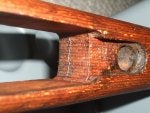I found a german late war laminated stock with cupped buttplate which should be correct for a HT that I am working on. It is a capture stock but in overall good shape. It should work, at least until I come across something better I'm willing to pay more for... So naturally it was covered in Cosmoline when I unpacked it. I spent some time reading up on the best way to remove Cosmoline without ruining the finish or risking delamination. I decided against harsh chemicals and set out to sweat the grease out. Next, wrapped the stock in paper towels followed by a trash bag and put it on the rear speaker deck of my car in the sun for the day. For about a week I changed out the grease soaked paper towels each day, rewrapped and rebaked. I know it's probably impossible to get all the grease out but I think I've removed a large amount of it and after wiping down the surface of the stock each day it is noticeably less sticky.
However, I did notice a crack in the stock behind the recoil lug. Not 100% sure if this was there before the baking process just covered in some grease i did not see or if it emerged after one of the heat cycles. Regardless, I'm guessing it should be repaired before firing. So, after more research on stock repair, I was thinking about clamping the area back into position and then using Acraglas epoxy over/in the crack. I could also drill a hole or two from the topside to insert brass rod with epoxy vertically to reinforce the area. Attached are some pics of the crack.
So if anyone could provide some opinion on:
1. Best way to repair this crack?
a. Acraglas in/over the crack(only)? b. brass rod reinforcement applied in the vertical? or c. a combination of both?
2. If brass rod repair is best for long term use, how many rods? A single rod centered or two, one positioned left and right to balance the recoil load?
3. Not sure if I should try to bake anymore cosmo out before or after the crack repair? I was going to finish with boiled linseed oil after some confidence most of the cosmo was out. If I apply the BLO too soon will I trap the cosmo in? I imagine that's not good for the wood.
4. This is a bit off topic for this post but are RSM scope rings OK for the HTs or is there a better repro. option?
However, I did notice a crack in the stock behind the recoil lug. Not 100% sure if this was there before the baking process just covered in some grease i did not see or if it emerged after one of the heat cycles. Regardless, I'm guessing it should be repaired before firing. So, after more research on stock repair, I was thinking about clamping the area back into position and then using Acraglas epoxy over/in the crack. I could also drill a hole or two from the topside to insert brass rod with epoxy vertically to reinforce the area. Attached are some pics of the crack.
So if anyone could provide some opinion on:
1. Best way to repair this crack?
a. Acraglas in/over the crack(only)? b. brass rod reinforcement applied in the vertical? or c. a combination of both?
2. If brass rod repair is best for long term use, how many rods? A single rod centered or two, one positioned left and right to balance the recoil load?
3. Not sure if I should try to bake anymore cosmo out before or after the crack repair? I was going to finish with boiled linseed oil after some confidence most of the cosmo was out. If I apply the BLO too soon will I trap the cosmo in? I imagine that's not good for the wood.
4. This is a bit off topic for this post but are RSM scope rings OK for the HTs or is there a better repro. option?







